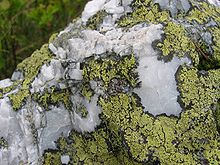| Rhizocarpon geographicum | |
|---|---|

| |
| Scientific classification | |
| Domain: | Eukaryota |
| Kingdom: | Fungi |
| Division: | Ascomycota |
| Class: | Lecanoromycetes |
| Order: | Rhizocarpales |
| Family: | Rhizocarpaceae |
| Genus: | Rhizocarpon |
| Species: | R. geographicum
|
| Binomial name | |
| Rhizocarpon geographicum | |
Rhizocarpon geographicum (the map lichen) is a species of lichen, which grows on rocks in mountainous areas of low air pollution. Each lichen is a flat patch bordered by a black line of fungal hyphae. These patches grow adjacent to each other, leading to the appearance of a map or a patchwork field.
When circular, or roughly circular, the diameter of this lichen species has been widely used to help determining the relative age of deposits, e.g. moraine systems, thus revealing evidence of glacial advances. The process is termed lichenometry. This technique is generally attributed to the work of Roland Beschel in the Alps.[1]
Lichenometry is based on the assumption that the largest lichen growing on a rock is the oldest individual. Generally, the five largest lichen thalli diameters are taken, although several statistical methods have been used. If the growth rate is known, the maximum lichen size will give a minimum age for when this rock was deposited. The growth rate curve, a graph of age of a lichen against the date of the substrate on which it is found has to be constructed for an area. Beschel originally used gravestones to produce a calibration curve. Growth rates for different areas and species can be obtained by measuring maximum lichen sizes on substrates of known age, such as gravestones, historic or prehistoric rock buildings, or moraines of known age (e.g. those deposited during the Little Ice Age).
- ^ Beschel, R. E. 1950. Flechten als Altersmaßstab rezenter Moränen.Zeitschrift für Gletscherkunde und Glazialgeologie NF, 1:151-62. (Translated by W. Barr as Lichens as a measure of the age of recent moraines. Arctic and Alpine Research, 5, 303-309)